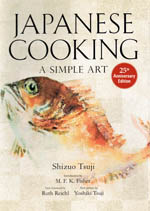Ingredients:
- 2.5-3 oz. (70-80g) chicken breast
- about 1 tsp sake
- about 1 tsp light soy sauce
- 4 small raw shrimp, shelled and deveined
- 1 lily root (yuri-ne) (optional)
- 12 stalks trefoil (or equivalent amount of young spinach or watercress)
- 12-16 raw ginkgo nuts, shelled and peeled (if available)
- 4 raw chestnuts, peeled and sliced
- Custard:
- 4 medium eggs
- 2 1/2 cups dashi or light chicken stock
- 1/2 tsp salt
- 1 tbsp mirin
- 1 tbsp light soy sauce
4 servings
Though the word custard evokes images of sweet eggy desserts, this is a delicate, stock-enriched, nonsweet egg custard containing chicken, shrimp, and assorted vegetables. Inventive cooks will be able to come up with any number of variations: you can add anything that complements the taste of the savory custard base, including sliced mushroom, small strips of lemon rind, parboiled carrot slices, or, as Japanese do, parboiled bamboo shoot slices, slices of kamaboko (fish paste), or even udon noodles.
Attesting to the general popularity of this dish, special lidded chawan-mushi cups are available in Japan wherever china is sold. You may safely use heatproof cups or conventional custard cups.
Chawan-mushi is one of the few Japanese dishes eaten with both chopsticks and a spoon. Even though the egg completely sets in steaming, the stock and juices released from various ingredients make the dish a little soupy. In fact, this dish is regarded by many as a soup and is often served as a soup course. In cold months it is brought to the table piping hot, and in summer it is very good chilled.
Directions
To prepare: Prepare all the solid ingredients first.
Cut chicken breast into 1/2-inch (15mm) morsels. Marinate in a scant amount of sake and light soy sauce for about 15 minutes. Drain; discard marinade.
Blanch shrimp in hot water for 30 seconds, remove, and pat dry. Leave whole, but if very large, slit half-open down the belly, press out flat, and cut in half crosswise.
Lily root is worth trying if you can find it. Its shape is somewhat like a flattened garlic bulb, but its flavor is mild and it has a pleasant, delicate texture. Separate bulb into segments and parboil gently in lightly salted water for 4-5 minutes. Drain. Wash trefoil or other greens, pat dry, and chop coarsely.
Shell and peel ginkgo nuts and use whole, if you are able to find fresh ones. Peel and slice chestnuts.
To assemble, steam and serve: Beat eggs in a medium-sized bowl. In another bowl mix the room-temperature dashi, salt, mirin, and light soy sauce. This recipe is one in which chicken stock is as good as dashi, not just a substitute. Pour stock mixture in a thin stream into beaten egg. Mix well, but do not beat. The surface of the mixture should be free of bubbles or foam. Strain. The seasoned stock mixture should be 3 times the volume of beaten egg, so apply this ratio of 3:1 in adjusting this recipe to the number of diners.
Divide the prepared solid ingredients between 4 cups, except for chopped trefoil or greens. Ladle the egg stock mixture into the cups, filling them to about 1/2 inch (15mm) from the top. Add chopped greens.
Cover each cup with plastic wrap or foil and set in a hot steamer. Cover steamer and steam over medium heat for 20 minutes, or place foil-covered cups in a bain-marie and cook in a preheated 425° F/ 220° C oven for 30 minutes.
The chawan-mushi is done when a toothpick inserted in the center comes out clean. The custard should be set but still jiggle freely. The volume of the custard will not increase much. It is overdone if the top is pocked or cracked and tough looking.
Serve hot or chilled and eat with a spoon and chopsticks. If you intend to serve chilled chawan-mushi, omit the chicken, which might develop an odor in refrigeration.

Reprinted with permission from the book:
Japanese Cooking: A Simple Art
Kodansha International
Easily the most comprehensive and exhaustive look at Japanese cuisine available, this groundbreaking classic marks its quarter-century anniversary in a revised edition with a new foreword by Gourmet editor-in-chief Ruth Reichl and a new preface by the late Tsuji's son, Yoshiki Tsuji.
Part cookbook, part philosophical treatise, this highly acclaimed collection offers a wealth of insight for amateurs and experts alike. Every technique associated with Japanese food is described step by step in great detail, along with illustrations to guide the reader through everything from filleting fish or cleaning an octopus to rolling omelets.
Sections on the Japanese meal, ingredients and selecting and cutting fish, chicken and vegetables offer great insight into the culture as well as the food. The recipe section of the book is divided by cooking method rather than food type, including grilled and pan-fried, steamed, simmered and deep-fried.
Dishes range from the simple, Pan-Broiled Salmon, to the more complex, Nagasaki-Style Braised Pork, and many dishes are vegetarian. Sushi and sashimi are covered in depth, as are knives, the proper way to slice the fish, and decorative presentations.
A complete guide to Japanese cooking, this collection is must-have for anyone interested in Japanese food or culture.
ISBN 978-4770030498
Y4800
- Order this book from amazon.com
- Order this book from amazon.co.jp (in Japan)
- Find this book at your local English-language bookstore in Japan
- Or use the ISBN to order from your local bookstore.







